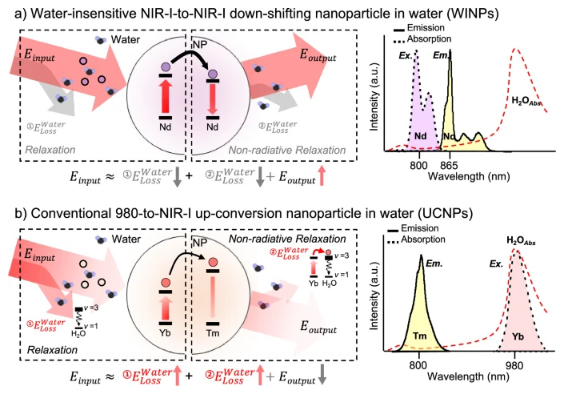
韩国汉阳大学Lee, Joonseok团队实现了对水不敏感的NIR-I-to-NIR-I下移纳米颗粒能够在不透明的水环境中以低功率阈值稳定地检测生物标志物。这一研究成果于2025年7月3日发表在《光:科学与应用》杂志上。
水环境下的发光猝灭对实际应用提出了挑战。镧系元素掺杂上转换纳米粒子(UCNPs)是近红外(NIR)发光荧光粉的代表,通常使用Yb3+离子作为敏化剂,需要980纳米光。该波长与水分子的跃迁相吻合,干扰了种群动力学,并且持续照射它们会导致意外加热。虽然Nd3+离子在800纳米材料作为替代增敏剂,其实际应用受到低量子产率(Q.Y.)的限制。
研究组开发了在NIR-I范围(700 - 900nm)内工作的水不敏感下移纳米颗粒(WINPs),以避免水干扰。通过单粒子级光谱表征,证明了其对水不敏感的特性,在干燥和水条件下具有相同的功率密度和寿命曲线。WINPs实现了较高的22.1±0.9% Q.Y.,可在比UCNPs低15倍的检测极限功率下运行,有效消除背景噪声,提高整体性能。
为了评估诊断潜力,研究组验证了基于winp的侧流免疫分析法(LFA)在65份不透明临床样本中检测禽流感病毒(AIVs)的方法,在仅100 mW cm2的情况下实现了100%的灵敏度和1.000的曲线下面积(AUC)。这些发现强调了WINPs作为水不敏感的近红外荧光粉的潜力,即使在富含水的环境中,也可以在低功率下工作。
附:英文原文
Title: Water-insensitive NIR-I-to-NIR-I down-shifting nanoparticles enable stable biomarker detection at low power thresholds in opaque aqueous environments
Author: Kang, Dongkyu, Kim, Suyeon, Goh, Yeongchang, Kim, Minseo, Lee, Sun-Hak, Kwon, Jung-Hoon, Nam, Sang Hwan, Lee, Joonseok
Issue&Volume: 2025-07-03
Abstract: Luminescence quenching in aqueous environments poses a challenge for practical applications. Lanthanide-doped up-conversion nanoparticles (UCNPs), representative of near-infrared (NIR)-emitting phosphors, typically utilize Yb3+ ions as sensitizers, requiring 980nm light. This wavelength coincides with the transitions of water molecules, interfering with population dynamics, and continuous irradiation causes unintended heating. Although Nd3+ ions, which absorb at 800nm, serve as alternative sensitizers, their practical use is limited by low quantum yield (Q.Y.). In this study, we developed water-insensitive down-shifting nanoparticles (WINPs) functioning within the NIR-I range (700–900nm) to avoid water interference. Characterization through single-particle-level spectroscopy demonstrated water-insensitive properties, with identical powers density and lifetime profiles under both dry and water conditions. The WINPs achieved a high Q.Y. of 22.1±0.9%, allowing operation at a detection limit power 15-fold lower than UCNPs, effectively eliminating background noise and enhancing overall performance. To assess diagnostic potential, we validated WINP-based lateral flow immunoassay (LFA) for detecting avian influenza viruses (AIVs) in 65 opaque clinical samples, achieving 100% sensitivity and an area under the curve (AUC) of 1.000 at only 100mWcm2. These findings highlight the potential of WINPs as water-insensitive NIR phosphors that can operate at low power, even in water-rich environments.
DOI: 10.1038/s41377-025-01882-2
Source: https://www.nature.com/articles/s41377-025-01882-2
Light: Science & Applications:《光:科学与应用》,创刊于2012年。隶属于施普林格·自然出版集团,最新IF:19.4
官方网址:https://www.nature.com/lsa/
投稿链接:https://mts-lsa.nature.com/cgi-bin/main.plex
